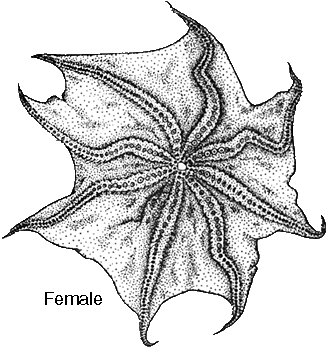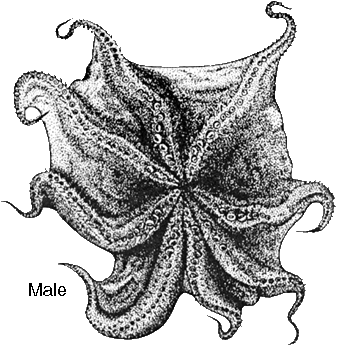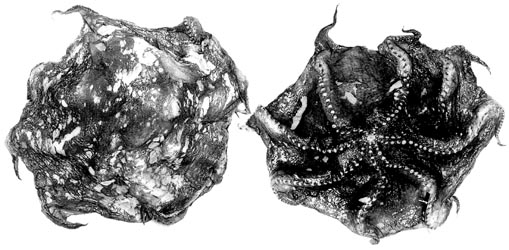Opisthoteuthis mero
Steve O'Shea, Richard E. Young, and Michael VecchioneIntroduction
O. mero is known from over 100 specimens. It appears to be the most common species of the genus in New Zealand waters.
Characteristics
- Arms
- Arms formula variable, arms IV usually shortest.
- Arms I in males without increased robustness.
- Suckers slightly larger in males (4.3-8.6% of ML) than in females (4.6-7.55% of ML).
- Males with only proximal field with greatly enlarged suckers.
- Suckers of proximal field slightly but abruptly enlarged; distal field virtually absent. Suckers 1-3 moderate in size, suckers 4 to 9-12 greatly enlarged, distally suckers decrease gradually but slightly to level of web, terminal 15-25 suckers decrease rapidly in size. [All arms apparently similar.]
- Up to 71 suckers on each arm.
- Web nodules not described.
- Cirrus length 4-10% of ML or 0.6-1.2 times maximum sucker diameter.
- First cirri between suckers 1 and 2.



Figure. Oral views of a female, 57 mm ML, and male, 54 mm ML O. mero. Drawings from O'Shea, 1999.
Comments
The above description is taken from O'Shea (1999). More details of the description of Opisthoteuthis mero can be found here.
O. persephone differs in almost always having 6 primary gill lamellae, and more suckers per arm (93). O. phillipi also has a high arm-sucker count. (Comparisons from O'Shea, 1999).
O. mero differs from all members of the genus (where males are known), except O. robsoni and O. depressa, in lacking distal fields or at least lacking an increase in sucker size in the distal fields. O. depressa differs from the other two in having more enlarged suckers on each arm of the proximal field (i.e., 16 vs 5-8). O. mero differs from O. robsoni in having a bilobular rather than a unilobular digestive gland.
Distribution
The type locality: Off the northern end of New Zealand, 36°52'S, 176°19'E, 510 m. The species is known from waters virtually all around New Zealand in depths of about 400-900 m (O'Shea, 1999).
References
O’Shea, Steve. 1999. The Marine Fauna of New Zealand: Octopoda (Mollusca: Cephalopoda). NIWA Biodiversity Memoir 112: 280pp.
About This Page
Steve O'Shea

Oceanic Sciences Research Institute, Auckland University of Technology, Auckland, New Zealand

University of Hawaii, Honolulu, HI, USA

National Museum of Natural History, Washington, D. C. , USA
Page copyright © 2016 , , and
All Rights Reserved.
- First online 13 May 2003
Citing this page:
O'Shea, Steve, Richard E. Young, and Michael Vecchione. 2003. Opisthoteuthis mero . Version 13 May 2003 (under construction). http://tolweb.org/Opisthoteuthis_mero/20163/2003.05.13 in The Tree of Life Web Project, http://tolweb.org/








 Go to quick links
Go to quick search
Go to navigation for this section of the ToL site
Go to detailed links for the ToL site
Go to quick links
Go to quick search
Go to navigation for this section of the ToL site
Go to detailed links for the ToL site